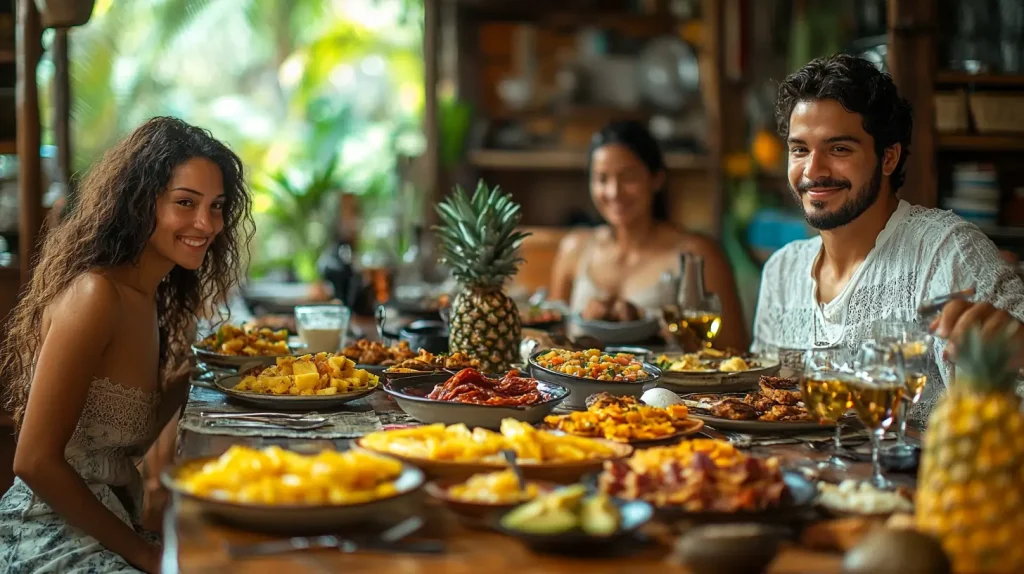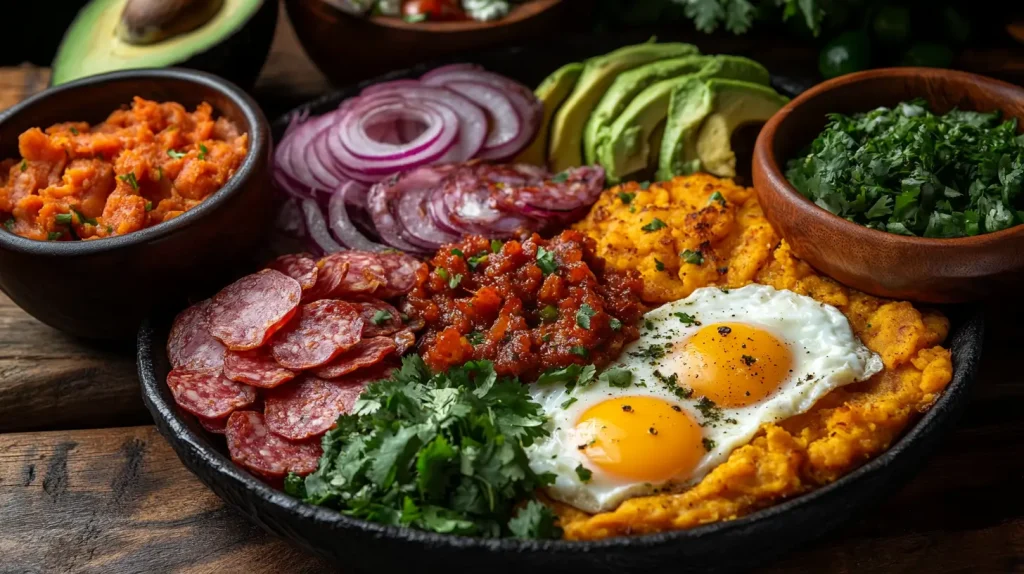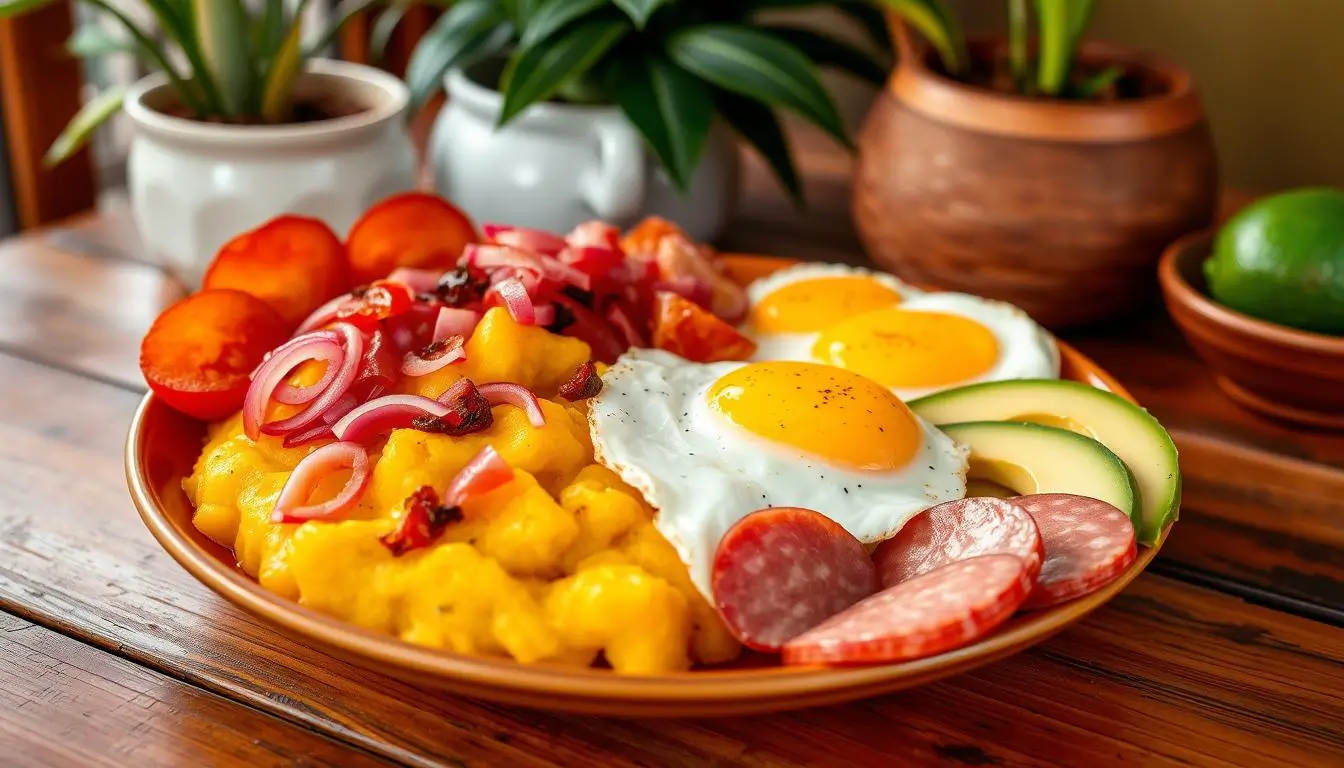Growing up in a vibrant Caribbean kitchen, I found the magic of a traditional Dominican breakfast. It turns simple mornings into special culinary moments. Mangú, a beloved dish, is at the heart of this breakfast. It’s more than food; it’s a celebration of Dominican heritage.
My first taste of mangú showed me why it’s special. The creamy mashed green plantains, crispy fried cheese, and savory salami tell a story. It’s a story of family, tradition, and deep culinary roots that go back generations.
Caribbean breakfast recipes are known for their bold flavors and healthy ingredients. Mangú is a great example of this tradition. It offers a delicious and filling start to the day. It brings people together through shared meals and memories.
Key Takeaways
- Mangú is the national breakfast dish of the Dominican Republic
- Green plantains are the main ingredient in this traditional breakfast
- The dish is usually served with fried eggs, cheese, and salami
- Plantains are very nutritious
- Dominican breakfast celebrates cultural heritage
The Cultural Significance of Dominican Breakfast
Dominican breakfasts are more than food. They weave together family, culture, and cooking traditions. In the Dominican Republic, breakfast is a special time for families. It’s a time to share food and strengthen bonds.

Caribbean breakfasts have a deep history. They show the mix of cultures, from African slaves to Spanish colonizers. This mix gives Dominican breakfasts their unique taste.
Early Morning Traditions and Family Gatherings
Families wake up early. Mothers and grandmothers start cooking as the sun rises. They make breakfast together, creating memories.
- Children help with the food
- They share stories at the table
- They make dishes like mangú
The Role of Breakfast in Dominican Society
Breakfast is more than a meal. It’s a key part of family life. It gives energy for the day and brings families closer.
“In every Dominican home, breakfast is a celebration of family and culture, much like a hearty Breakfast Scramble brings families together with its nutritious and customizable ingredients.”
Historical Development of Morning Meals
The history of Dominican breakfast is rich. It shows the island’s diverse past. Taino Indians, Africans, and Spanish settlers all left their mark on breakfast.
| Cultural Influence | Breakfast Contribution |
|---|---|
| African Slaves | Plantain preparation techniques |
| Spanish Colonizers | Cooking methods and spices |
| Taino Indians | Local ingredient integration |
Today, Dominican breakfasts keep changing. They mix old recipes with new ideas. But they always stay true to their cultural roots.
Understanding Mangú: The Heart of Dominican Breakfast

Mangú is more than a recipe. It’s a symbol of Dominican culture and tradition. This beloved dish connects families across the Caribbean island through food.
The origins of mangú are full of mystery. Some say it comes from African roots, like the Congolese word “mangusi”. Others think it started with U.S. soldiers in 1916, who loved the taste and said “Man, good!”
“Mangú is not just food; it’s a morning ritual that brings families together.” – Dominican Culinary Tradition
A traditional mangú recipe has a few steps:
- Select green, unripe plantains
- Boil the plantains until soft
- Mash thoroughly until creamy
- Season with salt and a touch of oil
What makes mangú special is its place in Los Tres Golpes (The Three Hits). This classic breakfast includes:
- Creamy mangú
- Fried eggs
- Dominican salami
- Fried cheese
A serving of mangú has about 240 calories. It’s full of fiber and minerals. It’s a delicious way to start the day, fueling families and celebrating their heritage.
Essential Ingredients for Traditional Morning Dishes
Dominican breakfast ingredients are key to a tasty morning. Each part adds special flavors and textures. This makes the breakfast truly special.

Green plantain recipes need to know the main ingredients. These ingredients are the base of Dominican breakfasts. They turn simple foods into amazing meals.
Green Plantains: The Star Ingredient
Green plantains are at the heart of Dominican breakfasts. They can be cooked in many ways. This makes them a must-have in Dominican dishes.
- Choose plantains that are bright green and slightly firm
- Look for smooth skin without major bruises
- Select plantains that feel heavy for their size
Traditional Seasonings and Flavor Enhancers
Dominican food loves strong flavors. The usual seasonings include:
- Adobo seasoning
- Fresh garlic
- Red onions
- Vinegar
- Salt and pepper
Fresh Local Ingredients
Dominican breakfasts shine with fresh, local items. Complementary ingredients like fresh eggs and local cheeses make the meal great.
“In Dominican cooking, every ingredient tells a story of tradition and family.” – Dominican Culinary Expert
These ingredients mix to make a breakfast that’s more than food. It’s a cultural experience.
Los Tres Golpes: The Complete Dominican Breakfast
Los Tres Golpes is the ultimate Dominican breakfast. It’s a mix of flavors that wakes up both locals and visitors. This dish is a true taste of Dominican morning food.
The name Los Tres Golpes means “the three hits.” It describes its main parts:
- Creamy mangú (mashed green plantains)
- Crispy fried eggs
- Savory fried Dominican salami
Each part of this breakfast adds something special. The plantains are a healthy base. They have lots of vitamin A, vitamin C, and potassium, just as the lean proteins in Chicken Breast Recipes provide essential nutrients for a balanced meal.
“Los Tres Golpes is not just a meal, it’s a cultural celebration on a plate!” – Dominican Food Enthuasiast
Other ingredients like queso de freír (frying cheese) and pickled red onions add to the dish. They make the flavors even more interesting.
| Ingredient | Nutritional Highlights |
|---|---|
| Green Plantains | High in Vitamin A, Low in Fat, Good Fiber Source |
| Fried Eggs | Protein Rich, Essential Amino Acids |
| Dominican Salami | Protein Source, Adds Savory Flavor |
For a real Dominican breakfast, try Los Tres Golpes. It’s more than food. It’s a tradition that brings families together. It celebrates the rich food culture of the Dominican Republic.
Step-by-Step Guide to Making Authentic Mangú
Learning to make mangú is key for those exploring Dominican cuisine. This traditional breakfast dish needs careful prep and detail. I’ll guide you through the authentic mangú recipe, capturing the essence of Dominican cooking.
Plantain Selection and Preparation
Choosing the right plantains is vital for authentic mangú. Look for green, unripe plantains that are firm and without blemishes. Here are some mangú cooking tips for your plantains:
- Choose 7 green plantains for a typical serving
- Wash the plantains thoroughly
- Carefully remove the skin using a sharp knife
- Cut plantains into large chunks for even cooking
Cooking Techniques and Tips
Mastering the cooking technique is key for perfect mangú. Follow these steps for an authentic result:
- Place plantain chunks in a pot with 4 cups of water
- Add 2 teaspoons of salt to the water
- Boil until plantains are fork-tender (approximately 15-20 minutes)
- Drain, but reserve some cooking water
Achieving the Perfect Consistency
The secret to amazing mangú is the right texture. Use these tips to make it creamy and smooth:
| Ingredient | Quantity | Purpose |
|---|---|---|
| Butter or Olive Oil | 4 tablespoons | Adds richness and smoothness |
| Reserved Cooking Water | As needed | Adjusts consistency |
| Salt | To taste | Enhances flavor |
Pro tip: Mash the plantains well, adding cooking water slowly for creaminess. The goal is to mash them thoroughly for a smooth texture.
“A perfect mangú should be smooth, creamy, and full of flavor – a true reflection of Dominican culinary tradition.”
Regional Variations and Modern Interpretations
Dominican breakfasts show the rich flavors of the Caribbean island. Each area adds its own twist to morning meals. This makes breakfasts in the Dominican Republic diverse and fun.
Modern mangú recipes mix old ways with new ingredients and cooking methods. Chefs are making this traditional dish fresh again. They keep its cultural roots but also attract new fans.
- Northern Region Specialties:
- Sancocho-inspired mangú with extra veggies
- Seafood in plantain dishes
- Eastern Region Innovations:
- Coconut milk in mangú
- Combining old and new flavors
- Southern Region Unique Interpretations:
- Spicier mangú with local peppers
- Grilled plantains
Breakfasts across the Dominican Republic are truly varied. Chefs use local ingredients to make new dishes. Mangú is a canvas for creativity, with endless possibilities.
“Our breakfast is a celebration of our history, culture, and creativity,” says Chef Maria Rodriguez, a prominent Dominican cuisine expert.
The Dominican breakfast scene is always changing and exciting. It blends old traditions with new ideas. This keeps breakfasts in the Dominican Republic lively and engaging.
Health Benefits and Nutritional Value
Dominican breakfast is more than tasty—it’s packed with nutrients. Plantains are the key, bringing health benefits that make it both filling and healthy.
Plantains have many health benefits. They offer a mix of nutrients that boost overall health.
Plantain Nutrition Facts
- Green plantains have about 203 calories per half portion
- They have 49 grams of carbs for lasting energy
- They give 655 milligrams of potassium (14% daily value)
- They have 4.5-6 grams of fiber per serving
- They are low in fat with about 3 grams of protein
Balanced Morning Meal Components
A traditional Dominican breakfast is perfectly balanced. It combines plantains with eggs and cheese. This mix supports your body’s needs.
“Nutrition is not just about eating—it’s about creating energy and vitality through thoughtful food choices.”
The Dominican breakfast is more than just food. Plantains have resistant starch, which is good for your gut and blood sugar. This meal is full of complex carbs, proteins, and vitamins. It keeps you energized and healthy all morning.
Key Nutritional Highlights
- Rich in Vitamin C, Vitamin B6, and Folate
- Contains antioxidants that fight free radicals
- Supports heart health
- Keeps you energized all morning
Looking for a healthy breakfast or wanting to try Dominican food? This meal is a great choice. It’s full of flavor and health benefits that nourish your body and soul.
Complementary Drinks and Side Dishes
Dominican breakfast is more than just food. It’s a colorful mix of drinks and sides that make mornings special. These add-ons bring the meal to life.
morir soñando is a famous drink in Dominican breakfasts. It’s made with orange juice, sweetened milk, and vanilla. It’s creamy and refreshing. Dominican coffee is also key, giving a boost of energy for the day.
Popular Side Dishes
- Sliced avocado with a sprinkle of salt
- Fresh tropical fruits like papaya and mango
- Crispy tostones (fried green plantains)
- Light morning soups for added nutrition
Side dishes show off Dominican cuisine’s rich heritage, and pairing them with a sweet dessert like Ritz Cracker Cookies can create a delightful contrast of flavors. Tostones, or fried plantains, add a crispy touch. Fresh fruits burst with sweetness and nutrients, starting the day right.
“Breakfast is not just a meal in the Dominican Republic – it’s a celebration of flavors and family tradition.”
Some families add light broths or fried treats to their breakfast. These extras show the Dominican love for filling, tasty morning meals. They give energy and comfort.
Conclusion
Exploring Dominican breakfast traditions showed me mangú is more than a meal. It’s a key part of their culture, linking families through food and memories. Mangú is a symbol of Dominican culinary history.
Breakfast in the Dominican Republic is all about family and history. It includes green plantains, eggs, and salami. Each dish tells a story of strength and creativity.
Breakfast in the Dominican Republic is a journey for the senses. It blends indigenous, African, and Spanish flavors. This mix makes their breakfast unique and special.
As we explore global food, Dominican breakfast shows the importance of food in keeping traditions alive. It’s not just about eating. It’s about enjoying a world of flavors and stories.
FAQ
What is mangú and why is it important in Dominican breakfast?
Mangú is a dish from the Dominican Republic. It’s made from mashed green plantains. It’s a key part of their breakfast, adding creaminess and flavor.
It may have come from Africa. It’s been a big part of Dominican food for over a century. It shows the rich food history of the Dominican Republic.
What are Los Tres Golpes?
Los Tres Golpes means “the three hits” in Spanish. It’s a classic Dominican breakfast. It has mangú, fried eggs, fried cheese, and fried salami.
This mix of foods gives a great taste and texture. It’s a filling and traditional way to start the day.
How do I make authentic mangú?
To make real mangú, pick green plantains and peel them well. Boil them until they’re soft, then mash with butter, water, and cream cheese.
For the topping, sauté red onions in vinegar and oil. The goal is to get it smooth like mashed potatoes.
What are the nutritional benefits of plantains in a Dominican breakfast?
Plantains are very good for you. They have more vitamins A and C, magnesium, and potassium than bananas. They’re also low in fat and sodium.
They’re a good source of fiber. A half-cup of cooked plantains has about 89 calories. With eggs, cheese, and meat, they make a balanced meal.
What drinks are typically served with a Dominican breakfast?
“Morir soñando” is a favorite drink. It’s made with orange juice, sweetened condensed milk, sugar, and vanilla. Coffee is also popular.
These drinks add sweetness or richness to the meal. They go well with the hearty breakfast.
Are there regional variations of Dominican breakfast?
Yes, mangú is a staple everywhere in the Dominican Republic. But, different areas have their own ways of making it. They might use different cheeses or meats.
Modern versions might include healthier options or international flavors. They might also add more vegetables or spices.
What is the cultural significance of Dominican breakfast?
Dominican breakfast is more than food. It’s a tradition that brings families together. Mothers and grandmothers often make it early in the morning.
Children help by getting eggs and peeling plantains. This breakfast shows the rich food history of the Dominican Republic. It mixes African, Spanish, and indigenous flavors.
Can I make a vegetarian version of the traditional Dominican breakfast?
Yes, you can make a vegetarian version. Just leave out the salami and sausage. Add more vegetables, vegetarian cheese, or plant-based proteins.
The mangú stays the same. This way, you can enjoy the core of this delicious breakfast tradition.

